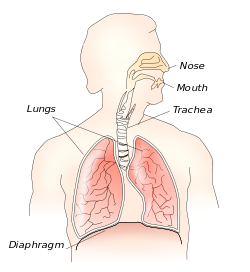
Take a Deep Breath…
Photo Credit: M Hooper (Creative Commons)
Note: This is the second post in a Stress Relief Series
Welcome back! If you didn’t read my last blog post, I recommend you go back there to get the foundation on how the stress response works. For those who did, I hope you had a chance to monitor your own unique stress triggers and reactions. Knowing your own response will greatly improve your ability to get relief from stress.
Bad Breath
We all breathe – all day, every day, whether we think about it or not, thanks to our autonomic nervous system (seriously, thank it – until you die, it’s always working for you).
Yet most of us do a crappy job of breathing. Terrible, in fact.
When you hold your breath or breath shallowly in the uppermost part of the lungs, you starve yourself of essential nourishment. Even worse, you’re most likely to do this when you need the support most: under stress.
It’s time to change that. Diaphragmatic breathing is the answer. Side benefit: it can be done anywhere, any time. You can start now and live better forever.

Photo Credit: ellajphillips (Creative Commons)
I know that sounds like a huge load of hyperbole. If the proven health benefits don’t convince you, feel free to go back to shallow. I’m betting you won’t.
Take a deep breath – and let’s get going.
Diaphragmatic Breathing: An Overview
Ever let out one of those huge sighs and feel immediately better? You know the ones – where you breathe way down deep and let it all go?
It’s called diaphragmatic breathing, and when you sigh that big, it’s because you’re loooong overdue for some quality oxygen supply and other bennies that you could be getting all day, every day, by diaphragmatic breathing.

Photo Credit: Wikipedia
Diaphragmatic or deep breathing involves breathing deep and low into the belly, using the diaphragm. The diaphragm is a dome-shaped muscle below your lungs that pushes down when inhale, bringing in more oxygen to the lungs and on exhale, pushing carbon dioxide out. Diaphragmatic breathing fully engages the lowest portion of the lungs, which contain most of the oxygen-carrying blood cells.
Because the sympathetic (fight-or-flight) and parasympathetic (relax and repair) systems cannot operate simultaneously, consistent diaphragmatic breathing restores the system to a normal state. Think of it as a system reset.
When you let out that deep sigh, you’ve likely been holding your breath or breathing shallowly, and this is your body’s way of attempting to correct the imbalance this causes. It feels good because it is good. It has immediate, beneficial effects on every part of your functioning.
A Treasure Trove of Benefits
I’ve broken these benefits into two general categories: improved body systems and relief from tension, pain, and anxiety. Each benefit on its own is impressive. Taken together, they highlight what a powerhouse the simple act of deep breathing is.
Improves and Strengthens Body Systems
- Reduces workload on the heart by (1) getting more oxygen to heart so it doesn’t have to work as hard transporting it throughout the body, (2) moving cortisol through (and out) of the body, and (3) creating a greater pressure differential in the lungs (which increases circulation), giving the heart a bit of a break
- Reduces toxins by releasing carbon dioxide and stimulating lymphatic drainage (and reducing demand on other systems that’d have to pick up the slack)

Photo Credit: bamalibrarylady (Creative Commons)
- Improves blood quality by removing carbon dioxide
- Makes lungs stronger and more powerful, guarding against respiratory problems
- Strengthens the immune system and metabolizes nutrients, as oxygen travels via red blood cells
- Digestive organs operate more efficiently due to increased oxygen in organs and food
- Increased oxygenation improves muscle functioning
- Movement of the diaphragm (a muscle) massages abdominal organs and the heart, improves circulation, and tones abdominal muscles
- Improves cellular regeneration
- Helps control weight: increased oxygen burns excess fat more efficiently in overweight people and feeds starving tissues and glands in underweight ones
Relieves tension, anxiety and pain
- Promotes the relaxation response by stimulating the vagus nerve near the diaphragm (and the home of about 75% of the body’s parasympathetic or ‘rest and repair’ nerve fibers)
- Releases tension caused by shallow breathing
- Produces more endorphins, elevating mood and reducing pain levels
- Increased brain oxygenation reduces anxiety levels and improves oxygen flow throughout the body. Brain is then less likely to perceive input as threatening and lowering anxiety, thus significantly turning down pain signals

Photo Credit: Raios de Luz – Gláucia Góes (Creative Commons)
- Boosts energy level and increases stamina
- Encourages good posture
Furthermore, nearly every religion, spiritual, and indigenous group acknowledges the importance of the breath. I don’t have room here to delve into the rich beliefs and references to the breath as life force, soul, prana, chi, and other integral aspects of our being. For many, the breath literally is life.
Room to Breathe
If you want a perfect demonstration of diaphragmatic breathing, watch babies as they sleep on their backs. Notice their little tummies rise calmly and fall with each breath. Their shoulders don’t rise, they don’t fill their chests with air, and they’re not tense.

Photo Credit: by daniella_caterina (Creative Commons)
We all started out breathing like this, but somewhere along the line, most of us lost it. We hold tension in our abdomens that forces the breath up into the chest and shoulder area. Culture likely plays a role, encouraging people to hold in their emotions. When we hold in emotions, we also hold our breath and our muscles, often unconsciously.
Lastly, there’s vanity. Tight waistbands and six-pack abs look great – amazing in fact. However, they promote (and often necessitate) poor breathing.
I’m not asking you to sub out skinny jeans for elastic-waist pants (except at Thanksgiving), but notice how your clothes affect your breathing. You might opt to unbutton your jeans every once in awhile (when appropriate) to let your tummy hang out and get some deliciously big, deep breaths. Review the long list of benefits if you need justification to commit this fashion faux pas.
The Practice of Diaphragmatic Breathing
If you’re new to this kind of practice, start by lying flat on your back. This position gives the diaphragm and abdomen the maximum amount of freedom to move. If you’re sitting, make sure to sit upright with spine straight and elongated, on the edge of the chair. When you slouch, you limit the diaphragm’s range of motion and crowd the abdominal cavity.
Take a deep, slow breath deep down into your belly, pushing your diaphragm down toward your pelvis. Your belly should expand, and yes, you are crowding your abdominal organs momentarily, which is fine.

Photo Credit: JPott (Creative Commons)
Your shoulders should not rise, nor should your chest move much, if at all. To help guide the breath low enough, gently rest your hand on your belly over your navel. Your hand should move with your breath.
Focus your attention on the breath going in through your nose, down your throat, through the chest, and down into the belly. Follow the breath out again, keeping the out-breath roughly the same length as the in-breath – a 4-count is generally a good place to start, although you may extend the count over time as long as it is still a comfortable breath pace for you. (You can also start with a shorter breath count if that’s better.)
You will get distracted and/or notice your mind racing. That’s absolutely normal. Noticing is most important, as you can simply redirect attention back to the breath count. Saying the numbers aloud may help your focus.
Eyes may be open or closed. Some people find it’s easier to focus on their breath with their eyes closed, while that causes other people to get wrapped up in their thoughts. Test this to see what works for you.
After practicing, notice how you feel. Is it different than before? If yes, where in your body is it different – and how so? What’s happened to your heart rate? Your breathing? Where have you released tension – and where does it remain? If you notice little or no difference at first, that’s fine. The changes may be subtle, and it can take time to get in tune with what’s happening in your body.
Practice – and Make It Playful Experimentation
Everyone is unique, so experimenting allows you to discover what works best for you. Based on what you notice, you may slow your breath even more, breathe out through the mouth vs. the nose, lie down, or extend your practice time.
Practice consistently and frequently. Diaphragmatic breathing is tremendously beneficial and is best done all day, every day. Since most of us have been holding our breath and breathing shallowly for decades, you need consistent practice for deep breathing to become second nature, especially if you want to remember to do it under stressful circumstances.

Photo Credit: Mr. T in DC (Creative Commons)
I recommend setting an alert or posting a prompt so that you deliberately practice at least three times a day for a few minutes. Practice as often as you can remember (i.e., every time you’re aware of your breathing), but make sure to have at least three times planned out for each day. You can start and end in bed – it’s the ideal practice place.
Other helpful times are when you’re typically waiting (e.g., on your commute, in the coffee line, before a meeting) or doing a routine activity that you don’t need to think about, like brushing your teeth, washing dishes, or taking a shower. This way, breathing practice doesn’t take any extra time out of your day.
Last, if you know a situation may be stressful, practice before and while doing it. Breathing deeply before and during a difficult conversation, picking up the kids, an important meeting, or a weekend trip to Costco can reduce the pain and help them go better.
While deep breathing alone won’t counteract all the effects of stress, it is the foundation of every other tool and technique (and involves changing a lifelong, unconscious pattern), so it’s critical to practice often.
Diaphragmatic Breathing: The Steps
- Sit upright or lie down on your back. If sitting, make sure that your spine is straight and elongated, and sit on the edge of the chair to give the abdomen as much room to expand as possible.
- Breathe in deeply and slowly into the diaphragm on a 4-count. Breathe in through the nose and all the way down deep into your belly, pushing your diaphragm down and extending the abdomen. Your shoulders should not move, and if you’re sitting up straight or lying down, your chest shouldn’t move much, if at all.
- Exhale on same count as the inhale. Exhale through your nose or mouth, whichever is most comfortable, for the same time length as the inhale.
- Focus attention on the breath and the count. As you take these deep, diaphragmatic breaths, focus on the breath as it moves in and out. Eyes may be open or closed.
Final Thoughts

Photo Credit: Prato9x (Creative Commons)
Because we breathe unconsciously all day long, our breathing patterns are so deeply ingrained that it takes lots of active practice to change it. Be diligent – and gentle with yourself when you notice that you’re holding your breath or shallow breathing. Even with practice, it will take awhile, possibly even months, to make deep breathing an unconscious habit.
Additionally, just like your biceps, the diaphragm is a muscle. If you haven’t been working it, it’ll take time to strengthen.
It’s common to feel light-headed when you start this practice. This could be due to two different reasons, so you’ll have to experiment a bit to know which could be operating for you. First, if you’ve been breathing shallowly prior to starting the practice, you may be close to hyperventilation. To interrupt that process, take a couple deep breaths, holding for a couple seconds before exhaling.
Second and most common, it may take time to get used to having that much oxygen moving through your system and carbon dioxide being released. Observe this – and take extra time to move from a lying or sitting position to give your body time to adjust.
This week, practice diaphragmatic breathing at least three times a day. Decide when you will practice, commit to those times, and post or set alerts to help you remember. Share your experiences and ask questions in the comments section below – and happy breathing!


What a comprehensive list of benefits of diaphragmatic breathing! Funny thing…I attended a Tony Robbins workshop in 2007 and there was a segment on deep breathing. I think it hypnotized me! Now, every time I hear the word “breathe” I automatically take several good, deep breaths. Thanks for the reminder of the importance of this practice.
That’s awesome, CherylAnn – although I meditated regularly now, I spend most of that time redirecting my monkey mind about a thousand times so I never get to that hypnotic or trance-like state. It’s a dream goal I hope to reach one day. I love it that you have such a simple association – it helps so much!
I found just what I was needed, and it was entirtaening!
I’m glad you found it helpful, Shermaine! 🙂
I have been reminded by different instructors and practitioners for years to belly breathe. Its funny how we have trained ourselves over our years into something that is really not our natural state. It will take some real efforts to get back to functioning that way all day but I am pretty good at doing some good deep breathing twice a day (mediation time and before I sleep) Your list of benefits is way longer than I expected though, worth the efforts I expect.
Kate, I too was pretty astounded by all the benefits. They definitely make it worth adding in a little extra practice. While it can take time to get into a regular habit, I’m a big fan of finding everyday situations that you can associate with practice so it gradually becomes habitual, unconscious. I notice now that I’m cued into my breathing as soon as I enter my home, when I sit down on my sofa, and when I’m on the subway (it comes in very handy on the subway, particularly during rush hour…).
Being able to do deep breathing during meditation and before sleep are two of the most important times, as they’re both occasions where you not only want to slow breathing but also want to redirect the busy mind to something to calm you into a theta state. Thanks so much for bringing that up!
Loving this stress series, Mary Beth!
I remember the first time I learned this technique… not surprisingly, it was in a yoga class.
I was astounded to realize I had been breathing incorrectly for most of my life.
I was actually quite a terrible breather and still find old habits showing up occasionally (as you said, usually when I’m under stress) where not only do I breathe shallowly, but I also hold my breath after an inhale. It’s rather odd and my partner comments on it which brings an awareness that I otherwise would have overlooked.
I now look forward to pranayama in my yoga practise, for this is when I experience all of the benefits belly breathing provides and it reminds me of how good proper breathing feels!
Thanks so much, Erica – I really appreciate that! I am also a breath-holder. It’s my biggest and most common offense, which I do after inhaling and exhaling – and sometimes mid-breath. It’s some sort of holding pattern. I’ve been working on it lately, being more conscious of my breathing and noticing when I’m doing it so I can change it.
Yoga has been so valuable in bringing many people’s attention to the breath and its importance. Sometimes I’m ambivalent as I see all these fit and power yoga classes at gyms, but overall when I see so many people embracing it, I can’t help but think that they’re all benefiting greatly from breathing during poses – and even more so for those who are taking more of a traditional yoga class with pranayama. Yoga was hugely transformative for me as well.
Thanks again for your comments – I’m so glad you brought up pranayama! 🙂
I have been a fan of deep breathing for much of my life, though sometimes I do forget when stressed. Thank your for the informative reminder to make a practice of intentional, deep breathing on a regular basis. Deep breathing can help with so many things. I know it helps when my asthma acts up, and I have a device called a “Respirate” that encourages slow, deep breathing over a period of time, which helps to lower blood pressure.
Hi there, Susan – the intentional practice can help increase the chances you’ll do it when you’re stressed. My nephew had asthma, and we used to do breathing practice with him. The Respirate sounds great – it’s so powerful when you get feedback about exactly what something’s doing in your body. Thanks so much for bringing in that valuable perspective!
I’ve done this – and it works so well for stress and anxiety! I used to have to take anti-anxiety medication to fly because any turbulence would make me want to crawl out of my skin. But this method of breathing I learned in a guided hypnosis track helps me now during flights, and any other stressful times. The secret is just being able to remember the technique is a tool available to me, and not getting wrapped up in what’s happening at the moment.
While I do not have difficulty flying, I’ve had several friends who have and I could see how difficult it was for them. Once on a flight, a man had a complete panic attack, and the flight attendant asked if there was a doctor on-board (there wasn’t). I could see the guy and told them I was a psychologist and asked if I could be of help. The flight attendant practically lifted me out of my seat. I took the guy through some breathing and talked with him a bit until he got himself settled. His seatmate gladly gave up his seat for me, and I had him match my breathing the rest of the flight. I felt so bad for him!
And you are soooo right about the secret being able to remember to use the technique. I think that may be the hardest part…